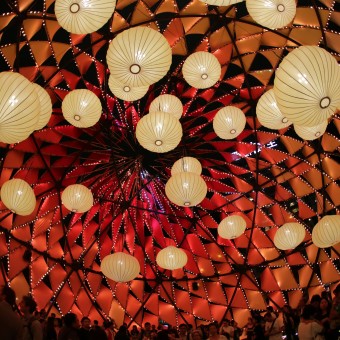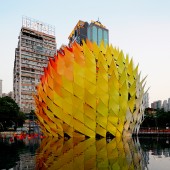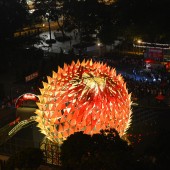
| THE AWARD |
| CATEGORIES |
| REGISTRATION |
| SUBMIT YOUR WORK |
| ENTRY INSTRUCTIONS |
| TERMS & CONDITIONS |
| PUBLICATIONS |
| DATES & FEES |
| METHODOLOGY |
| CONTACT |
| WINNERS |
| PRESS ROOM |
| GET INVOLVED |
| DESIGN PRIZE |
| DESIGN STORE |
| THE AWARD | JURY | CATEGORIES | REGISTRATION | PRESS | WINNERS | PUBLICATIONS | ENTRY INSTRUCTIONS |
Golden Moon Public Event Space by Laboratory for Explorative Architecture & Design Ltd. (LEAD) |
Home > Winners > Design #26831 >Interview |
 |
|
FS: What is the main principle, idea and inspiration behind your design?
L(: The Golden Moon revisits the concept of a Chinese lantern and makes a direct link to the legend of Chang’e, the Moon Goddess of Immortality – two elements strongly associated with the Mid-Autumn Festival. According to the romantic story Chang’e lives on the moon, away from her husband Houyi who lives on earth. The couple can only meet on the night of the Mid-Autumn Festival when the moon is at its fullest and most beautiful. To symbolise the passionate love burning between the reunited couple that day, the 6-storey-high, spherical moon lantern is clad with abstracted flames in fiery colours and patterns. Traditional materials for making lanterns, such as translucent fabric, metal wire and bamboo, have been translated to a large scale. A light-weight steel geodesic dome forms the pavilion’s primary structure and is the basis for a computer-generated grid wrapped around it. This grid is materialised through a secondary structure from bamboo. For this, Hong Kong’s traditional bamboo scaffolding techniques were used. This highly intuitive and imprecise craft was merged with exact digital design technology to accurately install and bend the bamboo sticks into a grid wrapping the steel dome. This grid was then clad with stretch fabric flames, all lit up by animated LED lights. The bamboo and flames follow a pattern based on an algorithm for sphere panellisation that produces purity and repetition around the equator and imperfection and approximation at the poles. This gradual change creates a very dynamic space that draws spectator’s view up towards the tip. By putting the axis of this cladding grid not vertical but under an angle, the dome gets an asymmetric directionality. This motion is reinforced by the entrance which is placed along this tilted axis to draw people into the sphere and where they get swept away along the grid’s tangents and vectors. The colouration of the pavilion amplifies this effect of submergence in a light wonderland. On top of the black painted steel structure, which forms a neutral base, eight different, saturated colours of stretch fabric are used for the flames. The colours gradually range from ivory and yellow to intense orange, red and deep bordeaux. The brightest colours are used at the tilted base whereas the darkest colours are used at the pole where they, together with the more scrambled geometry, make the pattern disintegrate into the black night sky.
FS: What has been your main focus in designing this work? Especially what did you want to achieve?
L(: The Golden Moon strategically combines digital design techniques, such as computer programming, with traditional crafts and basic materials. The Golden Moon was built in only 11 days and shows how complex geometry can be built at high speed and low cost with the simplest of means. This we call “Building Simplexity”. It rethinks the premise of digital design by anchoring the paradigm in a strong materiality. With over 400,000 visitors during its 6-day lifespan, the pavilion used its dynamic space, structure, colour, texture and light to trigger a sensuous response from visitors of 2012’s Mid-Autumn Festival.
FS: What are your future plans for this award winning design?
L(: The Golden Moon was a temporary installation and has entirely been recycled after 6 days of display. The concepts of combining contemporary design methods with alternative ways of constructing are a constant in our work and are carried forward into future projects.
FS: How long did it take you to design this particular concept?
L(: The Golden Moon fits in a series of projects where we experiment with materials and how e.g. computer programming can be combined with it to create a highly unique and expressive space for visitors to use. The competition proposal for the Golden Moon was designed in less than a week, but it benefited from work we have been developing over many years.
FS: Why did you design this particular concept? Was this design commissioned or did you decide to pursuit an inspiration?
L(: The Golden Moon is the 2012 Gold Award winning entry for the Lantern Wonderland design competition which is organised each year by the Hong Kong Tourism Board for the Mid-Autumn Festival, and was on display for 6 days in Hong Kong’s Victoria Park. After winning the competition we were commissioned to be develop it further over the summer leading up to the festival.
FS: Is your design being produced or used by another company, or do you plan to sell or lease the production rights or do you intent to produce your work yourself?
L(: We have received interests from people all over the world to bring over the Golden Moon. A city in Denmark for example wanted to use it for a festival there, and even within Hong Kong there were ideas circulating to give the project an afterlife. But because its story and construction principle is so closely related to Hong Kong and the Mid-Autumn Festival, and because it was always designed to be a singly highlight for the 2012 festival, the project was entirely recycled. It now lives on only as a memory and as photographs on thousands of peoples’ Facebook pages or mobile phones.
FS: What made you design this particular type of work?
L(: Over the past two decades digital design techniques have caused a revolution within the design world, opening the door to an unprecedented exploration of architectural form. However, due to the nature of the digital working environment, there has been an increasing dissociation between the virtual and the built environment. With this project we wanted to study how the digital paradigm can be grounded in the realities of “contractor space” and how, through this focus, the formal exploration can be materialised. In spite of automation and the prolific use of robotics in contemporary architecture and design, the act of constructing a building remains a largely human enterprise. The Golden Moon shows how, through a combination of state-of-the-art digital design technology and traditional hand craftsmanship, complex geometry can be built at high speed and low cost with the simplest of means.
FS: Where there any other designs and/or designers that helped the influence the design of your work?
L(: In Hong Kong bamboo is used for scaffolding, even if the project is a skyscraper. The bamboo scaffolding builders in Hong Kong taught us a lot on how they put structures together and what the geometric possibilities of their skills are.
FS: Who is the target customer for his design?
L(: The more than 400,000 visitors of the Hong Kong Mid-Autumn Festival.
FS: What sets this design apart from other similar or resembling concepts?
L(: The combination of a locally anchored narrative (the legend of Chang’e, the Moon Goddess of Immortality), the combination of contemporary design methods and local craftsmanship (digital design techniques and traditional bamboo scaffolding methods), and its unique and highly expressive form and appearance.
FS: How did you come up with the name for this design? What does it mean?
L(: For our competition entry we had initially named the project “Burning Moon”, as the idea was that the Moon would be burning from the passionate love between the two protagonists in the legend, Chang’e and Houyi. The link between love, passion and heat or fire, however, is a western concept, as in eastern cultures burning is related to either destruction or to sacrifice to the ancestors. Therefore, following our client’s advice the name was later changed to the more positive “Golden Moon”.
FS: Which design tools did you use when you were working on this project?
L(: 3D modelling and scripting software.
FS: What is the most unique aspect of your design?
L(: The fact that, thanks to the strategic incorporation of digital tools and local craftsmanship into the design and construction process, we managed to build a 6-storey high spherical dome with unique and highly complex patterning in only 11 days using the simplest of means: it’s “Building Simplexity”.
FS: Who did you collaborate with for this design? Did you work with people with technical / specialized skills?
L(: PROJECT MANAGEMENT TEAM: Kristof Crolla, Sebastien Delagrange, Dannes Kok, Kenneth Cheung and Yi Sa Chan of LEAD, and Nicholas Benner, Chris Lee (Anthropods Associates Ltd.), Paulina Lau (APT Engineering Consultant Ltd.) CONSTRUCTION: Free Form Construction Co. Ltd. (Main Contractor), Fonkwang Development Ltd. & Guangzhou Shipyard Company Ltd. (Steel), Wing Yick Scaffolders (Bamboo), Wings Design Production Ltd. (Fabric), LED Artist (LED) LIGHT & SOUND DESIGN: LED Artist
FS: What is the role of technology in this particular design?
L(: The project heavily relied on a combination of the latest digital design tools (e.g. programming of geometries) and the most traditional construction methods (e.g. bamboo scaffolding).
FS: Is your design influenced by data or analytical research in any way? What kind of research did you conduct for making this design?
L(: The Golden Moon uses Fibonacci sequences in the generation of the pattern and used extensive geometric data-analysis to generate the dozens of highly unusual drawings used on site for the construction of the project. The project builds up on research projects as, for example, the Dragon Skin Pavilion, built for the 2011-12 Hong Kong & Shenzhen Bi-City Biennale of Urbanism\Architecture. (http://www.l-e-a-d.pro/projects/dragon-skin-pavilion/2259). LEAD combines practice with research. Its research branch, called the “International Workshop Series”, has as an ambition to continue research on digital and information-based design methods and production techniques. Through lectures and the organisation of or participation in workshops worldwide, architecture students are introduced into advanced digital design, fabrication and design-oriented computer programming. With currently 18 completed editions in 11 countries as varied as the UK, China, South Africa, Finland or Chile, the goal is to continue exploring the combination of digital design and fabrication tools with local facilities and design agendas.
FS: What are some of the challenges you faced during the design/realization of your concept?
L(: The very short time-frame: 11 days on site. Adverse weather conditions: a huge “black rainstorm” stalled the construction process with a day, but luckily filled up the reflection pool halfway, saving valuable time and money on filling the pool up the next day.
FS: How did you decide to submit your design to an international design competition?
L(: International competitions are to everyday design practice what playing a grand-slam tournament is to going for a jog in the park. The stakes are high but so are the rewards. Winning and building this project was one of the greatest experiences we have had as architects and the warm reception by the city of Hong Kong was the most motivating moments for a young design practice like LEAD.
FS: What did you learn or how did you improve yourself during the designing of this work?
L(: We proved to ourselves and the building community that building conventions can be turned upside down and that invention is possible, if the mind-set is right, the team supportive and the process uncompromising.
FS: Any other things you would like to cover that have not been covered in these questions?
L(: Hong Kong is a fantastically intriguing and unique city. With competitions like the Mid-Autumn Festival Lantern Wonderland competition the city boldly gives a highly-needed platform to young designers and the creative industries to up the cultural position of Hong Kong. The city needs many more projects like this: there is a generation of eager designers desperately looking for an opportunity to contribute to the built environment. So we would like to thank our client, the Hong Kong Tourism Board, for their courage in setting up this project, and would like to encourage other cities in the region to follow their example.
FS: Thank you for providing us with this opportunity to interview you.
A' Design Award and Competitions grants rights to press members and bloggers to use parts of this interview. This interview is provided as it is; DesignPRWire and A' Design Award and Competitions cannot be held responsible for the answers given by participating designers.
| SOCIAL |
| + Add to Likes / Favorites | Send to My Email | Comment | View Press-Release |




